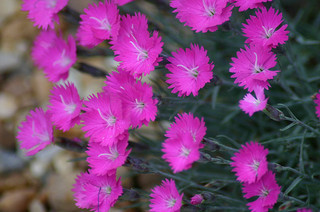Rare Flowers of Chalk Grassland

Nearly all the grassland, or downlands, of modern Britain are artificial habitats, created by man’s destruction of the forests. Neolithic people began to cut down the vast forests about 5,000 years ago, followed by the Celts and Romans, and they mainly concentrated on cultivating the lighter soils and higher ground. Cattle and sheep were grazed on the South Downs at this time, preventing them from reverting to woodland. When the Anglo-Saxons, using eight-ox ploughs to turn heavy clay soil, cleared many of the valleys, much of the farmland of the chalk and limestone hills was abandoned. Beech woodland took over the cultivated ground in many places but elsewhere sheep continue to graze, keeping the land clear of trees. Thus the chalk and limestone grasslands were formed.
Many plants depend upon lime for their growth. The soil on grasslands is shallow and the porous rocks below allow rain to drain away quickly. The main plants are grasses which form a short, springy turf. Typical flowers include many species of orchid, including the unusual bee orchid, cowslip, common milkwort and mountain pansy.
Several of the colourful grassland flowers have become very rare through human activities – mainly habitat destruction and digging up of plants. Remember to take care when walking on downlands: young plants are easily damaged when trodden on and a lot of trampling may compact the soil, preventing seeds from germinating.
 Cheddar Pink Dianthus gratianpolitanus
Cheddar Pink Dianthus gratianpolitanus
One of Britain’s rarest flowers, the cheddar pink is now fully protected. It is found only on the cliffs of Cheddar Gorge, Somerset. For years it was picked and dug up by collectors. The cheddar pink has large flowers which appear April-June.
The plant is 10-12cm in height.
 Spring Gentian Gentiana verna
Spring Gentian Gentiana verna
A dense cushion is formed by a rosette of the spring gentian’s lower leaves. The flowers are a rich, deep blue. This plant is only found in Yorkshire, Durham and Cumbria at altitudes of 366metres and above.
It is 2.5-15cm in height and flowers April-June.
 Pasqueflower Pulsatilla vulgaris
Pasqueflower Pulsatilla vulgaris
The flowers of this close relative of the anemones are large and violet-purple. It grows among grasses on dry, chalky slopes from Gloucestershire to Essex. The height of the plant is 10-30cm and it flowers April-May.
Things to do
1. Look up the three examples in an illustrated wild flower book and draw the flowers with pencil crayons.
2. Draw an outline of the map of Britain and mark all the present-day stretches of chalk grassland. Mark the spots where the three examples can be found.
3. Four other grassland flowers are mentioned on this fact sheet. Make a list of them and find out more about them, making your own notes and diagrams.
4. Some of our rare native flowers are commercially grown and can be bought from garden centres. If you are interested in gardening it’s a good idea to try creating your own mini-downland habitat – perhaps your school would be interested too. This is a very practical way to help prevent Britain’s beautiful flowers from becoming extinct.
